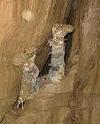This might interest some folks:
www.itrsonline.org/PapersFolder/2010/We ... SPaper.pdf
*kN*
Test of Trees for Anchors (presented ITRS 2010)
Moderator: Tim White
5 posts
• Page 1 of 1
- knudeNoggin
- Prolific Poster
- Posts: 190
- Joined: Mar 4, 2006 4:48 pm
- Location: Falls Church, Virginia, USA
Re: Test of Trees for Anchors (presented ITRS 2010)
Interesting study.
The data shows a leveling-off in failure strength of ~15kN in trees of ~5" or greater diameter. I can't tell if this was because they stopped pulling once they reached this force, or whether the trees all failed at around the same force regardless of diameter.
I would have liked to see more data on smaller diameter / weaker trees. The purpose of the study is choosing anchors for rescue, but I'd be interested in data on the strength of smaller trees that someone might use as a rappel or climbing anchor. A couple times in the past 3-4 years I've been forced to rappel off shrubs with stems <2" in diameter. These were "emergency" rappel situations in the desert where there weren't many anchor options. I chose small shrubs over placing a bolt. I rigged the anchor and conducted a bounce test to approximately 2x body weight before committing to the rappel (not a big safety margin). I've heard that these 1-2" diameter shrubs can sometimes hold several thousand pounds, but an extrapolation of the graph in this report would suggest otherwise.
I also almost always girth hitch any vegetation when lead climbing. This is generally only one point in a system of protection, but it would be good to know the strength of these anchors. When you're dealing with trees on ledges or near cliff edges I think most climbers believe it's nearly impossible to determine anchor strength. There are stories of 1" sapplings holding big leader falls, and there are also stories of 4' diameter anchor trees diappearing in the middle of the night just due to a strong wind. Climbers manage these uncertainties by generally using at least 2-3 points of equalized protection for belay anchors.
The data shows a leveling-off in failure strength of ~15kN in trees of ~5" or greater diameter. I can't tell if this was because they stopped pulling once they reached this force, or whether the trees all failed at around the same force regardless of diameter.
I would have liked to see more data on smaller diameter / weaker trees. The purpose of the study is choosing anchors for rescue, but I'd be interested in data on the strength of smaller trees that someone might use as a rappel or climbing anchor. A couple times in the past 3-4 years I've been forced to rappel off shrubs with stems <2" in diameter. These were "emergency" rappel situations in the desert where there weren't many anchor options. I chose small shrubs over placing a bolt. I rigged the anchor and conducted a bounce test to approximately 2x body weight before committing to the rappel (not a big safety margin). I've heard that these 1-2" diameter shrubs can sometimes hold several thousand pounds, but an extrapolation of the graph in this report would suggest otherwise.
I also almost always girth hitch any vegetation when lead climbing. This is generally only one point in a system of protection, but it would be good to know the strength of these anchors. When you're dealing with trees on ledges or near cliff edges I think most climbers believe it's nearly impossible to determine anchor strength. There are stories of 1" sapplings holding big leader falls, and there are also stories of 4' diameter anchor trees diappearing in the middle of the night just due to a strong wind. Climbers manage these uncertainties by generally using at least 2-3 points of equalized protection for belay anchors.
-

Extremeophile - NSS Hall Of Fame Poster
- Posts: 761
- Joined: Dec 7, 2009 7:37 pm
- Location: Littleton, CO
- Name: Derek Bristol
- NSS #: 34941
- Primary Grotto Affiliation: Colorado Grotto
Re: Test of Trees for Anchors (presented ITRS 2010)
Derek, the pull testing did end at 15kn. The four failure methods are outlined in the study as well as the reasons for chosing this particular stopping point.
If you ever get a chance to climb at Muir Valley in Kentucky, I'm sure Rick would be happy to talk your ear off about it. He's quite possibly the best landowner/steward you'll ever meet. He's done some other studies about bolting that you might be interested in reading as well, but all of them were performed in the Corbin sandstone of central kentucky, but if you climb in the desert and place bolts there, the results might be interesting to read as well.
If you ever get a chance to climb at Muir Valley in Kentucky, I'm sure Rick would be happy to talk your ear off about it. He's quite possibly the best landowner/steward you'll ever meet. He's done some other studies about bolting that you might be interested in reading as well, but all of them were performed in the Corbin sandstone of central kentucky, but if you climb in the desert and place bolts there, the results might be interesting to read as well.
Your words of caution are no match for my disaster style!
-

chh - NSS Hall Of Fame Poster
- Posts: 522
- Joined: Oct 4, 2005 3:21 pm
- Location: asheville, nc
- Name: caleb
- NSS #: 55745
Re: Test of Trees for Anchors (presented ITRS 2010)
Hello there, Derek!
Good to see some of your insightful input to the forum lately. Rick presented this paper at ITRS last year, which I attended. His actual presentation was much more thorough on the testing process, including pictures and detailed descriptions of results. Without the supplemental explanations and photos it can be hard to interpret the data as it's presented in the paper. Particularly of note - not all the tests were done with a wrap-3 pull-2 webbing anchor. In fact in nearly all of the small tree tests the pictures clearly showed a basket-style rigging (with no choking element). As a result the failure mechanism was typically the tree bending over enough until the webbing slid over the top, but not the tree uprooting. Some of the trees exhibited a peculiar effect that exacerbated the result - a section of bark would shear off and act as a little sled for the webbing to slide across the top of the bent over trunk easier.
I've found small trees/shrubs are usually hit or miss, though I'd say most people typically underestimate strengths in smaller diameters. The specifics of the grounding is of course much more important than with bigger trees. Let me know if you want to borrow a load cell to pull test some shrubbery on your next trip.
- Andrew
Good to see some of your insightful input to the forum lately. Rick presented this paper at ITRS last year, which I attended. His actual presentation was much more thorough on the testing process, including pictures and detailed descriptions of results. Without the supplemental explanations and photos it can be hard to interpret the data as it's presented in the paper. Particularly of note - not all the tests were done with a wrap-3 pull-2 webbing anchor. In fact in nearly all of the small tree tests the pictures clearly showed a basket-style rigging (with no choking element). As a result the failure mechanism was typically the tree bending over enough until the webbing slid over the top, but not the tree uprooting. Some of the trees exhibited a peculiar effect that exacerbated the result - a section of bark would shear off and act as a little sled for the webbing to slide across the top of the bent over trunk easier.
I've found small trees/shrubs are usually hit or miss, though I'd say most people typically underestimate strengths in smaller diameters. The specifics of the grounding is of course much more important than with bigger trees. Let me know if you want to borrow a load cell to pull test some shrubbery on your next trip.
- Andrew
-

PseudoFission - Infrequent Poster
- Posts: 22
- Joined: Feb 27, 2008 3:36 am
- Location: Boulder, Colorado
- Name: Andrew Blackstock
- NSS #: 58244
Re: Test of Trees for Anchors (presented ITRS 2010)
PseudoFission wrote: Some of the trees exhibited a peculiar effect that exacerbated the result - a section of bark would shear off and act as a little sled for the webbing to slide across the top of the bent over trunk easier.
- Andrew
This can also happen with choking hitches, though they are more reliable. Likelyhood is increased by species, health, and especially the season (for live trees). Though this particular failure method is not something I would typically worry about with normal climbing/caving loads or rescue loads mostly because of ways in which these anchors are typically set up. And any tree that would cause me to worry about a rescue load pulling the bark over it would likely be small enough for me to have thought twice about using it as a solitary anchor in the first place.
Your words of caution are no match for my disaster style!
-

chh - NSS Hall Of Fame Poster
- Posts: 522
- Joined: Oct 4, 2005 3:21 pm
- Location: asheville, nc
- Name: caleb
- NSS #: 55745
5 posts
• Page 1 of 1
Who is online
Users browsing this forum: No registered users

